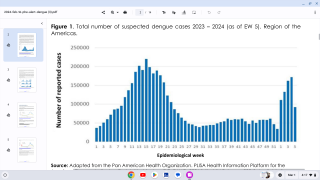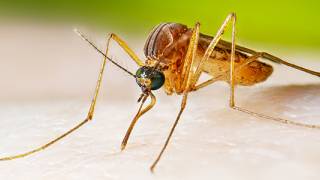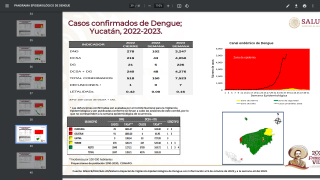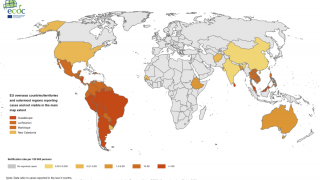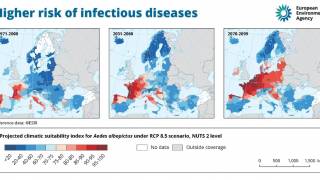Dengue and Zika Vaccine Candidates Are Temperature-Sensitive

A path toward creating vaccines to protect people from the dengue and Zika viruses involves the E protein, which covers the surface of each viral particle.
According to a new study, if researchers could develop strong antibodies against the E protein, then they would be able to create a formidable vaccine.
But, after decades of intense research, dengue and Zika virus vaccine development has had limited success.
Previous studies have shown that humans create strong antibodies to the E protein on the virus surface, suggesting that a soluble version of the E protein (called sRecE) could make a good vaccine.
Unfortunately, so far this has not panned out, and vaccines based on sRecE have failed.
Researchers from the University of North Carolina (UNC) School of Medicine researchers have identified a major barrier to a promising vaccine, a person’s body temperature.
UNC researchers led by Brian Kuhlman, Ph.D., professor of biochemistry and biophysics, and Aravinda de Silva, Ph.D., professor of microbiology and immunology, reported in a new study that body temperature reduces the pairing propensity of sRecE, and its ability to be recognized by these strong antibodies.
The surface of dengue and Zika viral particles are structurally similar.
Both viruses are coated with a single protein – called the envelope (E) protein.
Each virus contains 180 copies of the E protein on the surface, in pairs of two, known as homodimers.
A soluble version of the E protein, called sRecE, can form the same homodimer structure observed by E proteins on the surface of the virus.
These findings suggest that stabilizing the pairing propensity of sRecE may be critical to creating an effective vaccine.
“We’ve shown how our natural body temperature subverts sRecE potency and how future sRecE-based vaccine development needs to take temperature into account from the beginning,” said UNC graduate student Stephan Kudlacek, the first author on the JBC paper.
Also, a vaccine has to be created such that it doesn’t promote the immune system to make antibodies that recognize but can’t neutralize the virus.
If that happens, dengue and Zika can use these antibodies to infect immune system cells and make the infection more severe – this is called antibody-dependent enhancement.
Dengue- and Zika-infected patients develop neutralizing and protective antibodies that target specific regions on the E protein called epitopes.
This knowledge has led researchers to test whether the E protein or sRecE can serve as effective vaccines. Unfortunately, sRecE-based vaccines have performed poorly.
A particular class of the potent antibodies called the E Dimer Epitope (EDE) antibodies strikingly recognizes a region of the E protein in both dengue and Zika.
These antibodies are capable of neutralizing all four dengue serotypes and Zika. These discoveries suggest that to create effective vaccines, it will be important to engineer antigens that present these newly discovered dimer epitopes.
Dimer-specific epitopes could be the most straightforward kind to create if using recombinant proteins like sRecE. And it has been proposed that sRecE homodimers may function as effective vaccines.
But, previous studies have suggested that our natural body temperature of 98.6 degrees changes the E protein’s ability to pair and form homodimers on the virus surface.
Dr. Kudlacek said, “As typically observed, we found that colder temperatures help to keep proteins in their native or active structure. Because of this, we then tested to see how sRecE from three dengue serotypes and in Zika can form homodimers, as seen on the surface of the virus, in a buffer at room temperature.”
The UNC researchers discovered that dengue and Zika sRecE do form homodimers at room temperature.
Further analysis showed that the ability for DENV2 sRecE to form homodimers at body temperature is reduced 150 fold when compared to the ability to form homodimers at room temperature.
The researchers then wondered: since sRecE dimerization is reduced at physiological temperature, are antibodies that specifically recognize the E dimer able to bind to dengue and Zika sRecE at physiological temperature?
They tested this and found that the dengue and Zika sRecE homodimers fell apart at 98.6F, thus eliminating the dimer epitopes present in the sRecE homodimer and reducing antibody binding.
“Our results show that, at body temperature, the presence of dengue and Zika sRecE homodimers is greatly reduced, and the presence of sRecE monomer is increased,” Kudlacek said.
“This provides an explanation for why previous sRecE-based vaccine strategies have performed poorly, since body temperature favors monomer sRecE, thus focusing the immune system on generating more weakly neutralizing antibodies, which can result in disease enhancement, rather than producing potently neutralizing dimer-specific antibodies.”
For future sRecE-based vaccine development, this work suggests that the sRecE homodimer needs to be re-engineered to be stable at body temperature so the immune system can generate E dimer-specific antibodies strong enough to protect against disease instead of enhancing it.
The National Institutes of Health and the Centers for Disease Control and Prevention funded this research.
Our Trust Standards: Medical Advisory Committee






